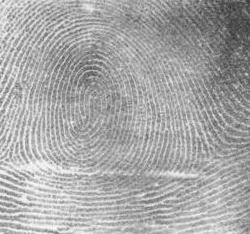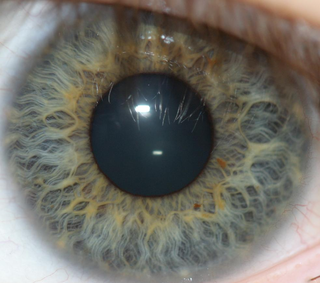Related Research Articles

A fingerprint is an impression left by the friction ridges of a human finger. The recovery of partial fingerprints from a crime scene is an important method of forensic science. Moisture and grease on a finger result in fingerprints on surfaces such as glass or metal. Deliberate impressions of entire fingerprints can be obtained by ink or other substances transferred from the peaks of friction ridges on the skin to a smooth surface such as paper. Fingerprint records normally contain impressions from the pad on the last joint of fingers and thumbs, though fingerprint cards also typically record portions of lower joint areas of the fingers.
Biometrics are body measurements and calculations related to human characteristics. Biometric authentication is used in computer science as a form of identification and access control. It is also used to identify individuals in groups that are under surveillance.

Iris recognition is an automated method of biometric identification that uses mathematical pattern-recognition techniques on video images of one or both of the irises of an individual's eyes, whose complex patterns are unique, stable, and can be seen from some distance. The discriminating powers of all biometric technologies depend on the amount of entropy they are able to encode and use in matching. Iris recognition is exceptional in this regard, enabling the avoidance of "collisions" even in cross-comparisons across massive populations. Its major limitation is that image acquisition from distances greater than a meter or two, or without cooperation, can be very difficult.

Law enforcement in Australia is one of the three major components of the country's justice system, along with courts and corrections. Law enforcement officers are employed by all three levels of government – federal, state/territory, and local.
CrimTrac was a former Agency in the Attorney-General's Department that was merged with the Australian Crime Commission on 1 July 2016 to form the Australian Criminal Intelligence Commission. Crimtrac had been responsible for developing and maintaining national information-sharing services between state, territory and federal law enforcement agencies.
Automated fingerprint identification is the process of using a computer to match fingerprints against a database of known and unknown prints in the fingerprint identification system. Automated fingerprint identification systems (AFIS) are primarily used by law enforcement agencies for criminal identification purposes, the most important of which is the identification of a person suspected of committing a crime or linking a suspect to other unsolved crimes.
The Henry Classification System is a long-standing method by which fingerprints are sorted by physiological characteristics for one-to-many searching. Developed by Hem Chandra Bose, Qazi Azizul Haque and Sir Edward Henry in the late 19th century for criminal investigations in British India, it was the basis of modern-day AFIS classification methods up until the 1990s. In recent years, the Henry Classification System has generally been replaced by ridge flow classification approaches.

The National Crime Records Bureau, abbreviated to NCRB, is an Indian government agency responsible for collecting and analysing crime data as defined by the Indian Penal Code (IPC) and Special and Local Laws (SLL). NCRB is headquartered in New Delhi and is part of the Ministry of Home Affairs (MHA), Government of India. The current Director of National Crime Record Bureau is Ramphal Pawar (IPS).
The Criminal Justice Information Services Division is a division of the United States Federal Bureau of Investigation (FBI) located in Clarksburg, Harrison County, West Virginia. The CJIS was established in February 1992 and is the largest division in the FBI.
The European Union Visa Information System (VIS) is a database containing information, including biometrics, on visa applications by Third Country Nationals requiring a visa to enter the Schengen area.
IDENT1 is the United Kingdom's central national database for holding, searching and comparing biometric information on those who come into contact with the police as detainees after being arrested. Information held includes fingerprints, palm prints and scene of crime marks.
Automated Fingerprint Identification System (AFIS) can refer to
The Child Alert Foundation (CAF) is a private, 501c(3) non-profit organization that was established in the state of Pennsylvania in 1998. Operating strictly from donations and fund raising, CAF is dedicated to assisting federal and local law enforcement agencies in the recovery of missing and abducted children and elderly individuals. The Child Alert Foundation helps law enforcement notify their surrounding communities with their copyrighted Abduction Central Alert (ACA) community alert notification system.

Vein matching, also called vascular technology, is a technique of biometric identification through the analysis of the patterns of blood vessels visible from the surface of the skin. Though used by the Federal Bureau of Investigation and the Central Intelligence Agency, this method of identification is still in development and has not yet been universally adopted by crime labs as it is not considered as reliable as more established techniques, such as fingerprinting. However, it can be used in conjunction with existing forensic data in support of a conclusion.
The Integrated Automated Fingerprint Identification System (IAFIS) is a computerized system maintained by the Federal Bureau of Investigation (FBI) since 1999. It is a national automated fingerprint identification and criminal history system. IAFIS provides automated fingerprint search capabilities, latent searching capability, electronic image storage, and electronic exchange of fingerprints and responses. IAFIS houses the fingerprints and criminal histories of 70 million subjects in the criminal master file, 31 million civil prints and fingerprints from 73,000 known and suspected terrorists processed by the U.S. or by international law enforcement agencies.

The Ghana Card is a national Identity card that is issued by the Ghanaian authorities to Ghanaian citizens – both resident and non-resident, and legally and permanently resident foreign nationals. It is proof of identity, citizenship and residence of the holder. The current version is in ID1 format and biometric.
Biometrics refers to the automated recognition of individuals based on their biological and behavioral characteristics, not to be confused with statistical biometrics; which is used to analyse data in the biological sciences. Biometrics for the purposes of identification may involve DNA matching, facial recognition, fingerprints, retina and iris scanning, voice analysis, handwriting, gait, and even body odor.
Identix Incorporated, established in August 1982, designed, developed, manufactured, and marketed user authentication solutions by capturing and/or comparing fingerprints for security applications and personal identification. Markets included corporate enterprise security, intranet, extranet, internet, wireless Web access and security, E-commerce, government, and law enforcement agencies.
Joseph Henry Wegstein was an American computer scientist.

Automated border control systems (ABC) or eGates are automated self-service barriers which use data stored in a chip in biometric passports along with a photo or fingerprint taken at the time of entering the eGates to verify the passport holder's identity. Travellers undergo biometric verification using facial or iris recognition, fingerprints, or a combination of modalities. After the identification process is complete and the passport holder's identity is verified, a physical barrier such as a gate or turnstile opens to permit passage. If the passport holder's identification is not verified or if the system malfunctions, then the gate or turnstile does not open and an immigration officer will meet the person. E-gates came about in the mid-2000s as an automated method of reading the then-newly ICAO mandated e-passports.